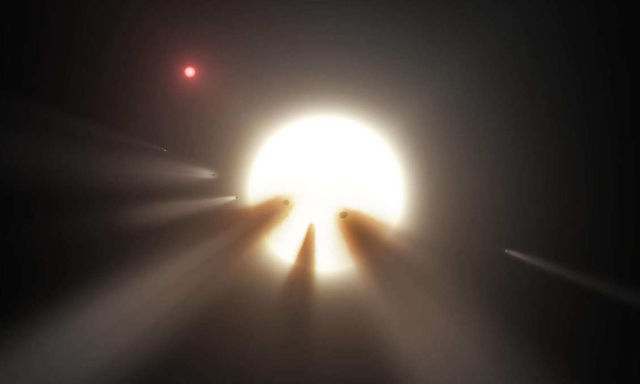Astronomers believe there really is something weird happening around KIC 8462852 star, that’s 1480 light-years away.
Described by scientists who search for extraterrestrial civilizations, as the “most mysterious star in our galaxy,” KIC 8462852, located 1480 light-years away, is monitored constantly from the Kepler space telescope.
Kepler monitored more than 150,000 stars, but this particular one has a weird distortion, that might be the result of a giant alien construction project.
The leading hypothesis, up until now, was that a group of comets around the star occasionally are blocking a huge portions of its light.
A new paper, published on the arXiv, says that this hypothesis is unlikely as well.
Tabetha Boyajian from Yale, a lead researcher on the team that originally discovered the star, explains:
“We’d never seen anything like this star. It was really weird. We thought it might be bad data or movement on the spacecraft, but everything checked out.”
Astronomer Bradley Shaefer from Louisiana State University, said:
“In the past 100 years or so, the star’s brightness has dipped by 16.5 to 19.3 percent. This trend is ‘completely unprecedented’ for a star of this type. Such stars should be very stable in brightness, with evolution making for changes only on time scales of many millions of years.”
Shaefer explains, concerning the comets theory:
“I do not see how it is possible for something like 648,000 giant comets to exist around one star, nor to have their orbits orchestrated so as to all pass in front of the star within the last century. So I take this century-long dimming as a strong argument against the comet-family hypothesis to explain the Kepler dips.”
Tabetha Boyajian, told New Scientist:
“This presents some trouble for the comet hypothesis. We need more data through continuous monitoring to figure out what is going on.”
But just because science doesn’t yet have any idea on what’s happening at KIC 8462852 star, doesn’t mean it’s aliens.
Image credit NASA/JPL-Caltech
Read more here (PDF): arXiv
via newscientist






Leave A Comment